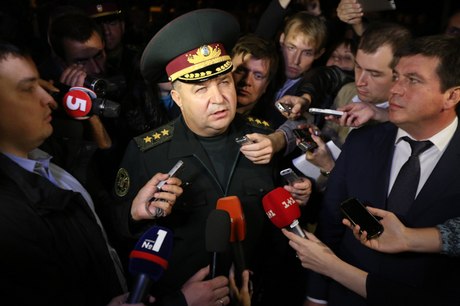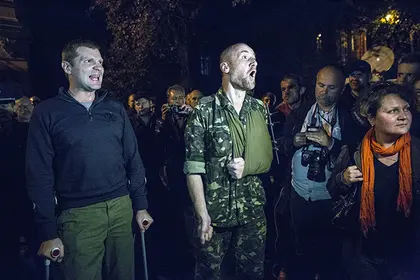On
Oct. 13, several hundred soldiers of the National Guard left their military units in Kyiv and the region to
rally near the Presidential Administration, demanding the end of
draft. National Guard units are staffed though national
mobilization, but the terms of service for these particular units
have been extended several times beyond the usual one year.
Artyom
Skoropadsky, the Right Sector’s spokesman, said by phone that the
demonstration was a provocation that could have been orchestrated by
Russia’s Federal Security Service.
JOIN US ON TELEGRAM
Follow our coverage of the war on the @Kyivpost_official.
Interior
Minister Arsen Avakov said on Oct. 14 that the incident would be
investigated.

More photos from the protest.
“Demobilization
is never above military duty and honor,” he wrote on Facebook.
“…Several hours of demobilization slogans turned these guys, most
of whom have fought (in Donbas), from respectable soldiers into young
people we’re ashamed of.”
Anton
Gerashchenko, an advisor to the interior minister, wrote on Facebook
on Oct. 13 that Russian intelligence agencies had used the situation
and were behind social network groups that coordinated the protest.
One
of their groups on Russia’s Vkontakte social network, called the
Life of a Soldier, featured a St. George ribbon, a symbol of
pro-Russian insurgents, and the Donetsk People’s Republic and
Luhansk People’s Republic hashtags.
Gerashchenko
said that the soldiers should be punished but added that the military
draft system should be changed. “What
happened today at the soldiers’ rallies proves that the military
service system urgently needs reform,” Gerashchenko said.
The
National Guard soldiers represented units 3030, 3066 and 3027.
Many
of the soldiers interviewed by the Kyiv Post on Oct. 13 said they had
clashed with protesters during the EuroMaidan revolution, when they
protected government buildings. They also said they disapproved of
the revolution.
They
said that they were hoping their demands would be met, since
EuroMaidan protesters had done the same. “Maidan
managed to achieve their goals,” Ihor, a 21-year National Guard
soldier, said. He refused to give his last name for fear of
prosecution.

Anatoly
Matios, Ukraine’s chief military prosecutor and Yury Viytev,
military prosecutor of the Central District, tried for hours to
persuade the soldiers to disperse, saying that they were subject to
criminal punishment for their actions.
Stepan
Poltorak, head of the National Guard who was appointed defense
minister on Oct. 14, also talked to the demonstrators.
Andrei,
another 21-year-old guardsman, said that soldiers from the Sumy,
Zaporizhya, Kharkiv and Chernihiv oblasts were expected to join them.
But the rally ended by midnight on Oct. 13.
Several
volunteer battalion fighters also came to the presidential
administration, arguing that the National Guardsmen’s behavior was
treason.
EuroMaidan
activists also debated with the National Guardsmen. When the National
Guard soldiers said that they had been tired of serving since the
EuroMaidan Revolution, the activists wondered why they had protected
Berkut riot police from EuroMaidan demonstrators.
Kyiv
Post staff writer Oleg Sukhov can be reached at reaganx84@gmail.com.

You can also highlight the text and press Ctrl + Enter




